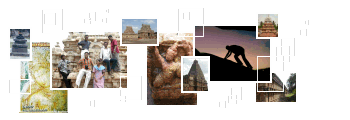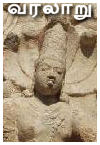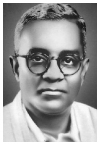 |
 |
 |
http://www.varalaaru.com A Monthly Web Magazine for South Asian History [185 Issues] [1827 Articles] |
 |
 |
 |
http://www.varalaaru.com A Monthly Web Magazine for South Asian History [185 Issues] [1827 Articles] |
|
Issue No. 129

இதழ் 129 [ அக்டோபர் 2016 ] 
இந்த இதழில்.. In this Issue.. 
|
INSCRIPTIONS There are fifteen inscriptions in this temple, inscribed on the walls of the vimana and mandapa. Twelve inscriptions are copied in the years 1890 and 1917 and published in the ARE of the respective years. Among the twelve copied inscriptions text for five inscriptions are published in the SII Vols. IV (391, 392, 393) and XIX (166, 438). Inscriptions of Parantaka I, Rajaraja I, Rajendra I are found in this temple. Among the fifteen inscriptions four inscriptions mentions Parakesari (SII XIX : 166, 438, SII IV : 392, 393) and five belong to Rajakesari (SII IV : 391, ARE 1917: 198, 199, 201, 202) and the rest of the inscriptions carry no king name. Among the unnamed inscriptions, two inscriptions that are found on the eastern side of the vimana belong to later period, probably C.E. 18th century. Among the four Parakesari inscriptions, the one on the northern wall of the vimana belong to Rajendra Chola I (SII IV:392) which also carries the prasasti ‘Thirumanni valara’. The other three Parakesari inscriptions are assigned to Parantaka I. Two 34th regnal year inscriptions are found, in that one (SII IV:166) carries the soubriquet ‘Madiraikonda koparakesari’, the other one (SII 19:438) is also assigned to the same king due to high regnal year. A sixth regnal year inscription (SII 19:166) carries an epithet ‘Danadunga’, one of the title of Parantaka I, hence assigned to the same ruler. All the five Rajakesari inscriptions, (SII 4:391, ARE 1917: 198, 199, 201, 202) belong to Rajaraja I as it carries the prasasti ‘Thirumagal pola’. The inscriptions mention the village as Thirunombalur and the deity as Mahadevar of Thirunombalur. The inscriptions of Rajaraja I gleam that the village Thirunombalur was a suburb of Devanapalli under the administrative division of Tattaikalanadu a sub division of Keralantaga valanadu. Apart from Thirunombalur; Devanapalli, Keralapalli, Sirrur are the other villages known through the inscriptions. Miymalanadu, Tattaikkalanadu are the Nadu divisions and Keralantaga valanadu is the Valanadu division mentioned in the inscriptions. Inscriptions speak about endowment of gold, cattle, land for burning lamps, ornaments and other offerings. Six inscriptions speak about gift of gold and cattle for burning lamp. Pirantakan Purushottaman a member of the Danatonga-terinja-Kaikkola endowed 2 ½ kalanju of gold for burning lamp during the three Sandhis. Five kalanju of gold was endowed by certain Araiyan Kaman a resident of Sirrur for burning perpetual lamp. Besides, a day lamp was endowed by a lady of Devanapalli. Two inscriptions speak about endowment of cattle for burning lamp. Singan Solaiyan, a vellala resident of Devanapalli endowed 15 cows for a perpetual lamp. The job was entrusted to the Temple authorities to look after daily a measure of (ulakku) ghee provided for the purpose. Another inscription speaks about gift of 2 cows for a lamp, as like, the job was entrusted to the temple authorities. Two 21st regnal year inscription of Rajaraja I speak about gift of land for offerings to Thiurnombalur Mahadevar. A native of Devanapalli gifted land for offerings and other expenses on Ayanasamkrama days to the God. Two inscriptions speak about additions in the temple. A 34 regnal year inscription of Parantaka I speak about the laying of outer layer of the wall by certain Mummadi Kiranirami. An authorless inscription (ARE1917-204) belonging to C.E. 10th century speaks about the gift of Dvarapalas by certain Nirttalaivayan Tenunikaman Eluvan alias Devanaganapalli-Araiyan. Inscriptions also gleams offence by public servants and levying of fine as sentence by the Ur. Two inscriptions of Rajaraja I speak about levying of fine for offences committed by the public servants. A 17th regnal year inscription (ARE1917-199) reveals fine collected from defaulting servants was utilized for making a diadem to the Thirunombalur Mahadevar. A 16th regnal year inscription (ARE1890-67) speaks about fine levied to members of Rajarajadevar Kaikolappadai for their offence against Temple authorities and the 3 kalanju of gold was gifted to god of Thirunombalur. Inscriptions also gleams two of the regiments that prevailed in the region. Danatonga-terinja-Kaikkola, Rajarajadeva Kaikolappadai, the former during the time of Parantaka I and the latter during Rajaraja I. Inscriptions also bring to limelight two officers viz., Thiruvadigal Chattan (ARE 1917, 199), a survey officer (Ulagalavittan) of the region during Rajaraja I period and Kuzhalur udaiyar, an officer of Nadu division (probably Tattaikalanadu). The activities of Ur, Thirukkoiludaiyargal in the local administration are gleamed through inscriptions. ‘Kaseitangal’ the standard gold measure of the region is known through the inscription. Pirantakan Purushottaman, Araiyan Kaman, Mummadik kiranirami, Pirantaka Therinja Kaikolar, Sundarachola Therinja Kaikolar, Pandikulasani Therinja Kaikolar, Kuzhalur udaiyar, Nirttalaivayan Tenunikaman Eluvan alias Devanaganapalli-Araiyan are the individuals mentioned in the inscriptions. To sum-up, the inscriptions reveal the socio-political aspects of the region during the Chola period as it was under their patronization, especially Rajaraja I. The temple is noted for its simple and elegant architecture. The gana frieze in the valabhi is a important feature to mention. The prevalence of the Parantaka I’s inscriptions authenticates his authorship to the temple. Besides, architectural features also corroborate it. Erumbur, Allur Nakkar koil, Thirunamanallur are the other ekatala vimana temples of Parantaka I. all these temples are noted for its simple and elegant architecture. Except Thirunamanallur the rest of the temples have padabandha adhishthana, while the former has pratibandha adhishthana. One of the common feature that we find among the ekatala vimana temples of Parantaka I is the absence of niches in the mukha mandapa. This tradition is also found in the temples of Aditya I, it can be taken that it was continued by Parantaka I in his early temples. With all these it is interesting to note that this temple still remain in all its virginity escaping from the vandalism of nature and human, standing as one of the best example for an early Chola architecture. |

சிறப்பிதழ்கள் Special Issues 

புகைப்படத் தொகுப்பு Photo Gallery 
|
| (C) 2004, varalaaru.com. All articles are copyrighted to respective authors. Unauthorized reproduction of any article, image or audio/video contents published here, without the prior approval of the authors or varalaaru.com are strictly prohibited. | ||